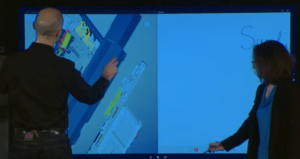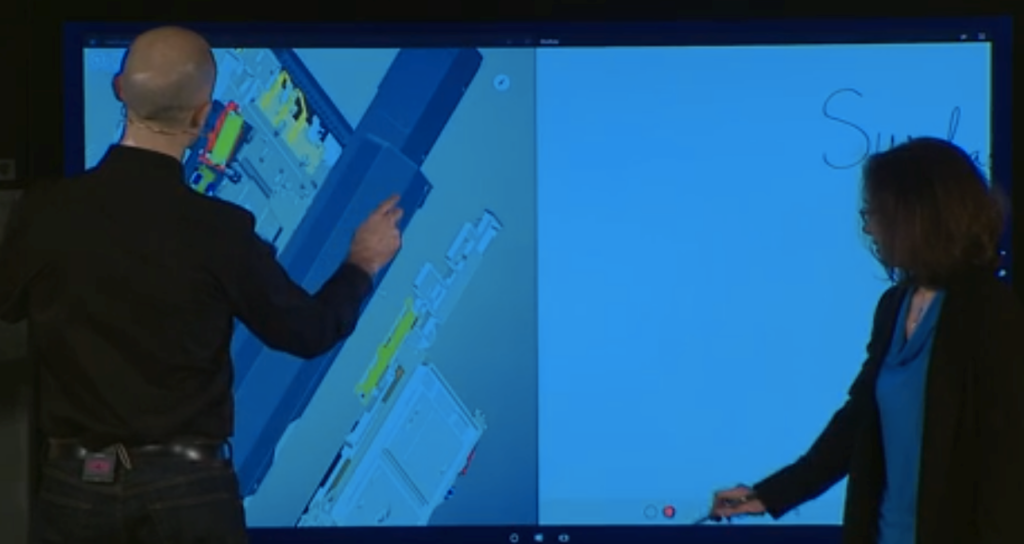Windows 10 will arrive with two new products for work and play. The Surface Hub is a high-end white board for show and tell and save and share and the HoloLens is another take on wearable augmented reality.
The Microsoft Surface Hub, was unveiled during the Windows 10 update in Seattle. It was a bit of a surprise, but one many Microsoft followers could predict after previous Surface updates and Microsoft’s acquisition of Perceptive Pixel in 2012. In addition, we’ve been seeing large format Surface displays making the round at CAD conferences where Microsoft is obviously seeding the base.
The new Surface Hub is a computer based on i5 or i7 Core processors embedded in a 4K screen. It will be available in two sizes, 84-inch and 55-inch and it has everything. The screen has vertical audio and video bars that sit on either side of the screen with array microphones sensitive enough to identify the active speaker. The Surface Hub includes dual 1080p cameras, which capture the meeting room and also the person standing at the screen. Microsoft says the system is sensitive enough to enable remote participants to make eye contact with people in the room. It supports Bluetooth, Wi-Fi, and NFC. True to the Surface multi-touch vision, the display supports 100 points of touch and it has stylus support as well.

The Surface Hub has built-in Skype and a specially designed OneNote whiteboard app. In Microsoft’s demonstration, Senior Director, Security Business, Hayete Gallot talked about the usual challenges of getting a meeting started and then distributing materials after the meeting. She used a large model from Siemens NX to illustrate how a team can evaluate a design, annotate it and share notes. In essence, Gallot told the audience, we all have a lot of meetings and we all know that there must be a better way of having those meetings. The idea is that the Hub can enable more useful meetings by allowing easy access to content, it adds the ability to annotate content on the screen, such as web pages, and the meeting can easily be recorded and distributed via OneNote.

HoloLens
If the Windows Surface Hub seems to focus primarily on work, the HoloLens is a lot about play. Microsoft unveiled a slick looking (at least compared to the current Virtual Reality Rigs from Oculus and Sony) head-set for Augmented Reality. It lets people walk around at least somewhat safely with a see-through, high-def display and without a wire tether, and it gives users the ability to see and interact with 3D objects using gestures. The device is built around a CPU/GPU and a new processor Microsoft is calling an HPU (Holographic Processing Unit), which (we think) processes and combines real world data and 3D digital data. PC World cites an anonymous source and claims the CPU is a custom Cherry Trail processor from Intel. The system also includes spatial sound to enhance the immersive effect. The company says the HoloLens will be introduced within the Windows 10 time frame, which is a pretty broad designation.
As the name suggests, Microsoft is calling their technology holography and the company promises the device will come with a cute 3D content creation app called HoloStudio, which enables users to pick and combine primitive shapes to make something that can then be 3D printed. It’s an interface designed by Hollywood. Tony Stark will find it clunky, Tom Cruise’s Minority Report guy will think it’s too slow, but this is the future we have today.
One goal for HoloLens, says Microsoft developer Alex Kipman is to mix apps and games into the real world. Kipman comes from the Kinect team. He said Microsoft is actively pursuing new innovation or future devices and he said the HoloLens will help unleash creativity with applications like HoloStudio. Microsoft says the HoloLens will also play an important role in scientific exploration as well. The company worked with JPL to create an immersive view of Mars using (we believe) the data gathered by the Rovers’ 3D vision sensors. In this usage model, the HoloLens can function as a personal CAVE, which could be set up and used much more casually than today’s room-sized installations.
What do we think?
So far the multi-touch Surface has been great if you’re delivering news about the weather or predicting election results. Also, Surface shows up in the occasional hotel lobby but the world has been waiting for Microsoft to bring the multi-touch out into the world. Here it is one step closer as an actual product and at least some discussion of ship dates. More important, Microsoft has developed an interface and application suite around the product. On this first round, the product will be expensive, but not fearsomely so. After all, 4K screens are now selling for less than $100o and prices are plunging as sales rise. It will be a bargain for businesses looking for a better tool for meetings with remote participants.
As for the HoloLens, well Google has made it easy for everyone who comes after. Sure, you’ll look like an idiot walking around in one of these, but you won’t look like a superior, supercilious jerk who is participating in the wholesale gentrification of neighborhoods and driving out longtime residents … or maybe that’s too specific a reference. The HoloLens is designed for home or office use with customized applications, but we can also see the potential for the technology to be used for information helmets or windshields.






